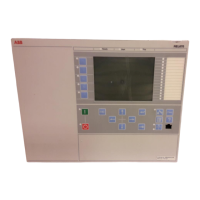circulating current from the local HMI (Icc_i), calculate the value for
circulating current voltage adjustment Uci.
EQUATION2088 V1 EN-US (Equation 14)
The voltage regulation algorithm then increases (for transformer T2) or
decreases (for transformer T1) the measured voltage by Udi and compares Ui
against the voltage deadband limits U1 and U2 for the purposes of voltage
regulation.
EQUATION2090 V3 EN-US (Equation 15)
9. To cause a tap change, the calculated value for circulating current voltage
adjustment must offset the injected quantity for bus voltage U
B
so that Ui is
outside the voltage deadband created by setting UDeadband. Expressed by
equation 16 and equation 17.
EQUATION2092 V2 EN-US (Equation 16)
EQUATION2094 V2 EN-US (Equation 17)
(for the purposes of this test procedure)
Therfore:
_ 2Ci Icc i Xi U Uset× × > -
EQUATION2096 V1 EN-US (Equation 18)
( )
( )
2
_
U Uset
Icc i
Ci Xi
-
>
×
EQUATION2098 V1 EN-US (Equation 19)
10. Using the settings for USet, UDeadband, C (Compensating factor) and Xr2
(transformer short circuit impedance) calculate the magnitude of Icc_i
necessary to cause a tap change command.
11. Inject current equal to I2Base for Transformer 1 and (I2Base - |Icc_i|) for
Transformer 2 so that the magnitude of calculated circulating current will
cause a raise command to be issued for Transformer 2 and a lower command
for Transformer 1. Magnitude and direction of circulating currents measured
for each transformer can be observed as service values on the local HMI and
Section 10 1MRK 506 377-UEN C
Testing functionality by secondary injection
150 Railway application RER670 2.2 IEC
Commissioning manual

